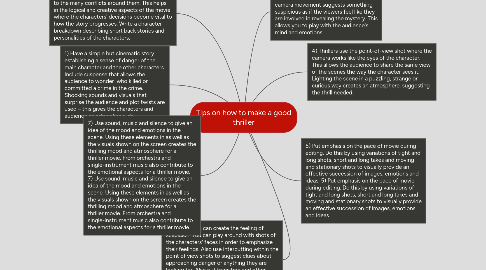Tips on how to make a good thriller
by Damita Dickerson

1. 1) Have a simple but cinematic story establishing a sense of danger of the main character and the other characters. Include suspense that allows the audience to wonder who killed or committed a crime in the crime. Shocking sounds and visuals that surprise the audience and plot twists are used – this gives the characters and audience an adrenaline rush.
2. 2) Have strong characters in your story in order to give good reason for how they react to the many conflicts around them. This helps in the logical and creative aspects of the movie where the characters' decisions become vital to how the story progresses. Write a character breakdown describing short back stories and personalities of the characters.
3. 6) Simple cuts can create the feeling of suspicion. You can play around with shots of the characters' faces in order to emphasize their feelings. Also use intercutting within the point of view shots to suggest clues about approaching danger or anything they are looking for. Also put transition and other visual effects in the scenes during editing to establish a physical, emotional or even supernatural dilemma.
4. 7) Use sound, music and silence to give an idea of the mood and emotions in the scene. Using these elements in as well as the visuals shown on the screen creates the thrilling mood and atmosphere for a thriller movie. From orchestra and single-instrument music also contribute to the emotional aspects for a thriller movie. 7) Use sound, music and silence to give an idea of the mood and emotions in the scene. Using these elements in as well as the visuals shown on the screen creates the thrilling mood and atmosphere for a thriller movie. From orchestra and single-instrument music also contribute to the emotional aspects for a thriller movie.
5. 3) Make the camera roam around in various shots. Camera movement or no camera movement suggests something suspicious as if the viewers feel like they are involved in revealing the mystery. This allows you to play with the audience's mind and emotions.
6. 5) Put emphasis on the pace of movie during editing. Do this by using variations of tight and long shots, short and long takes and moving and stationary shots to visually provide an effective succession of images, emotions and ideas. 5) Put emphasis on the pace of movie during editing. Do this by using variations of tight and long shots, short and long takes and moving and stationary shots to visually provide an effective succession of images, emotions and ideas.
7. 4) Thrillers use the point-of-view shot where the camera works like the eyes of the character. This allows the audience to share the same view of the scenes the way the character sees it. Lighting the scene in a puzzling, strange or curious way creates an atmosphere, suggesting the thrill needed.


